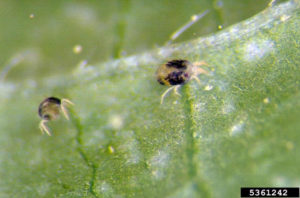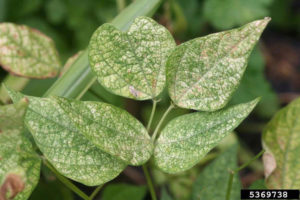Twospotted spider mite outbreaks are usually associated with drought conditions and populations can increase rapidly as drought conditions become more severe. Over 1200 plant species world-wide are reported to serve as hosts for the twospotted spider mite. Violets, chickweed, pokeweed, wild mustard, henbit, vetch, and blackberry serve as common hosts and are often the source of infestations that develop on adjacent crops.
Description
Twospotted spider mite eggs are very small, globular and translucent and found on the underside of the leaf. The larva hatch from the egg pale green with six legs. There are two nymphal instars (protonymph and deutonymph) with a resting stage between them and another resting stage between the deutonymph and adult. The nymphs are pale green with darker markings and have eight legs. The adult female is about 1/80-inch long, pale green or greenish-yellow with two darker patches on the body, and oval-shaped with long hairs on the dorsal side (Figure 1). Overwintering females are orange-red in color. The male has a smaller, narrower, more pointed body than the female. While visible with the naked eye, the detail can only be seen with a hand lens in the field or a microscope.

Figure 1. Twospotted spider mite females. (Image courtesy of Frank Peairs, Colorado State University, Bugwood.org.)
Biology
In warmer climates, twospotted spider mites overwinter as adults in the soil or on weed hosts. In mild winter weather, they continue to feed and lay eggs, although development is much slower than in the summer. In severe winter climates, the mite overwinters in the soil and begins to feed on weed hosts when the weather warms. The development of the mite is rapid, particularly at high temperatures. At the optimum temperature for development, 86 to 90°F, the egg stage lasts three to five days, the larval/nymphal stages four to five days, and a pre-oviposition period of one to two days, the total life cycle takes only eight to 12 days. A female can lay an average of 90 to 110 eggs during a lifetime of about 30 days. The mites begin to disperse after weed host damage becomes severe. They use a technique called “ballooning” where they migrate to the top of the plant and are carried a substantial distance from the original host by the slightest breeze.
How does the twospotted spider mite injure soybean?
Mites feed by piercing the cells and sucking out the fluid in the cells, this injury results in white or yellow stippling on the underside of the leaf (Figure 2).

Figure 2. Twospotted spider mite injury to soybean leaf. (Image courtesy of Whitney Cranshaw, Colorado State University, Bugwood.org.)
As the injury continues, photosynthetic capacity is reduced and water loss from the leaf increases dramatically. If the population continues to increase, leaf color progresses from a gray-green, to yellow, to finally copper, prior to dropping
from the plant. Economic injury reduces pod set and seed size. Occasionally, symptoms can be confused with actual drought symptoms. Injury often begins on the lower canopy and progresses upward on the plant. If an insecticide or miticide is applied, the field should be resampled after an application has been made to assess the population as another treatment may be necessary. The critical window for maximum damage response in the plant is R3 to R4.
How can twospotted spider mites be sampled on soybean?
Begin by inspecting soybean plants near the field edge or in stressed areas of the field that appear “drought stressed”, particularly edges next to an alfalfa field that has recently been cut. Pull plants and examine the leaves beginning at the bottom of the plant. If stippling or webbing is noticed, examine the surface with a hand lens or tap the leaves over a white piece of paper attached to a clipboard. It is not important to count the mites, just to confirm the presence. To determine how far the mites have dispersed into the field move at least 100 feet into the field and walk a U-shaped pattern examining two plants in 20 locations along the route. It is important to check population growth every four to five days when conditions are favorable as populations can quickly reach very high levels.
Is there a treatment guideline for twospotted spider mites on soybean?
There is no hard and fast economic injury level associated with when to apply a miticide, but the following guideline is beneficial in reaching a decision.

Why do twospotted spider mite populations increase so rapidly in a drought?
Drought conditions increase the movement of spider mite populations to soybean because the original host plants dry down or are harvested (in the case of alfalfa) and drought conditions improve the quality of soybean as a food source for the mite– it reduces the natural occurring fungal pathogen that attacks the mite, and it allows twospotted mite reproduction out pace its predators.
What are the options if both soybean aphid and twospotted spider mites are at damaging levels?
Although uncommon, it may be possible that both pests are at treatable populations at the same time. What is more common is that one is at treatable levels and the other is present, but below an economic level. In either case, care must be used when deciding on which insecticide or miticide to use as it could impact the pest. Some insecticides may result in a flair up of mite populations as they can remove beneficial predators and allow increased reproduction potential. Consult your chemical provider for recommendations for an appropriate product.
Article Link – Managing Twospotted Spider Mites in Soybean Fields
